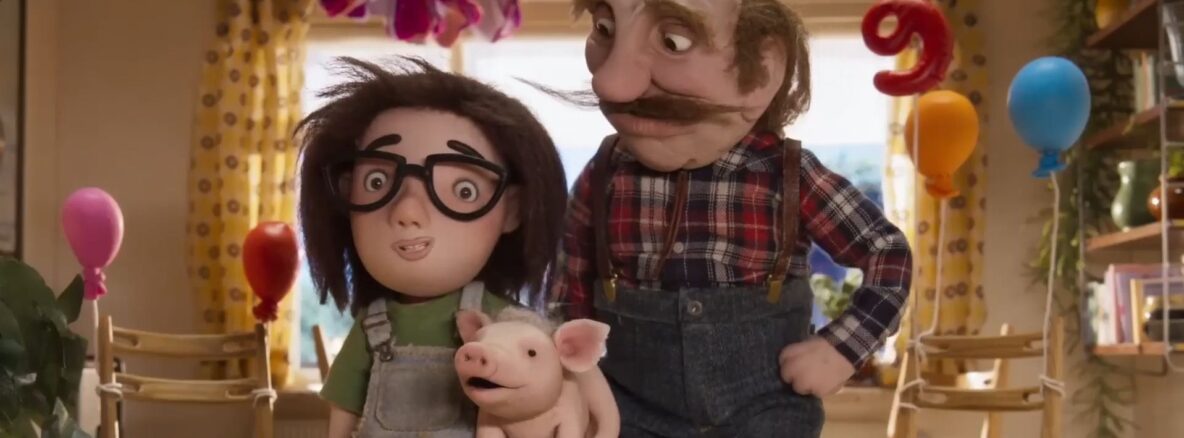
Mascha Halberstad about OINK
“Not all people are good”
When nine year old Babs gets a piglet as a gift from her mysterious Grandfather Tuitjes, her mother – a hardliner vegetarian – isn’t exactly pleased. Babs does everything she can to teach ‘Oink’ some manners, so she can keep him. As occupied as she is with her mission, little does she notice how a villain has evil plans for her beloved pig.
Never before had a feature animation film been made in stop-motion in the Netherlands. And then suddenly there was OINK, a film combining an overwhelming charm with a surprising amount of excrement. Mascha Halberstad and her team have worked for almost eight years on this plainly hilarious and exciting animation.
OINK looks rather ‘Dutch’, both in its sets – those tight residential areas! – and in its somewhat ‘cheeky’ style.
Mascha Halberstad: That’s where the story takes place: in a Dutch village. I wanted to show the country as most Dutch people know it. Not the touristic tulip-and-windmill-Netherlands, but the identical-terraced-house-Netherlands, with its typical interiors, its characteristic paved streets with fences, pavements and drains, and its inevitable Canta LX in the driveway. It is actually an ode to my childhood and to the Holland I grew up in. Only I chose a house from the 1950s – because I found them more beautiful – while I myself lived in a house dated 20 years later.
Yet the film will be released worldwide, so it must have some universal appeal.
Halberstad: It’s all in the theme. OINK is about trust, about the loss of trust and about ‘not to be trusted’. This is mainly reflected in the relationships between Babs and her granddad, and between her mother and father. So there is a whole narrative line for adults, while the poo is mainly addressing the children.
Yet the underlying story is pretty intense. Is that what attracted you to Tosca Menten’s book?
Halberstad: Definitely! There are many differences between the original book and my movie, but that element has certainly remained. I like that there’s a character who simply turns out to be a plain jerk, because in real life, not all people are good.
Especially for the film you created your own animation studio. Why did you need one?
Halberstad: I founded the Holy Motion animation studio together with producer Marleen Slot. We thought it was a waste of money to rent a space, as finishing a stop-motion movie might take you several years. So we bought a 650 square metres space literally around the corner from my home. A good investment, as we can rent it out to other filmmakers.
Does that studio allow you to work according to your own principles?
Halberstad: I used to work at home, where I had little space. As a result, I got used to working on a very small scale. Minuscule almost! At Pedri Animation – the company that builds our puppets – they were surprised. For most assignments, they make puppets that are 3 times as big, which allows them to work very refined. But I’m not looking for polished perfection. In OINK, you can simply see the seams and stitches, and I don’t want to polish them away; you can see that it is handmade. You can touch our dolls and pick them up.
Or you can give them as a present to singer Liam Howlett of The Prodigy, as you did with the puppets used for the music video for their song Wild Frontier. Where does the job of a stop-motion director begin and end?
Halberstad: Basically, I do everything except animating – which I do miss somehow. From writing the screenplay to designing the puppets, from creating the whole film universe to directing the actors, the animators and the editing. I also created all secondary characters. I first made the puppets myself, and immediately gave them a clear character. Those examples then went to the puppet makers at Pedri, who really knew how to perfectly convert my designs. As a director, I am carrying the entire load. Fortunately, the stop-motion process is very fluid and easily allows you to improvise. Perfect for a self-taught artist like me; I didn’t follow an animation film course, but I did follow my intuition!
And stop-motion is where your intuiting brought you?
Halberstad: What I love about stop-motion is that what you see is what you get. You can approach your film like a live action shoot: on the set, you can still adjust the lighting, you can move the camera a bit, and so on. I love playing with those elements. We are currently finishing the short prequel KING SAUSAGE (22′), in which you see how Babs’ parents fall in love with each other. This allows me to hang out in that stop-motion universe a bit longer.
I wish Babs’ parents the same sensation as their daughter, in my favourite moment of the entire film: the kiss, when she suddenly folds her knee. Delightful!
Interview conducted by Fien Meynendonckx for ECFA Journal.
Discover more of Mascha Halberstad’s films on Animation HUB.
